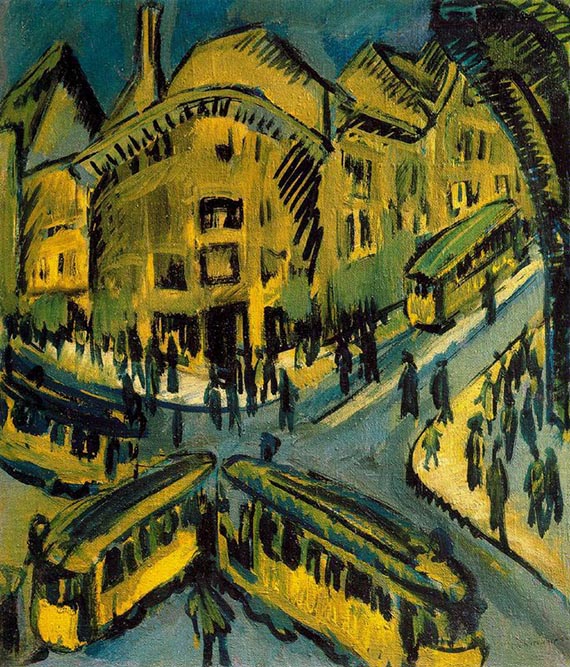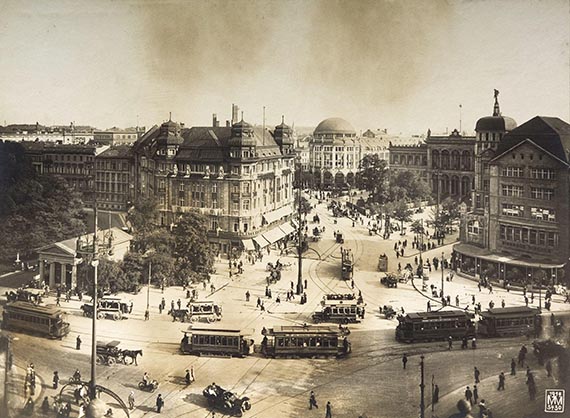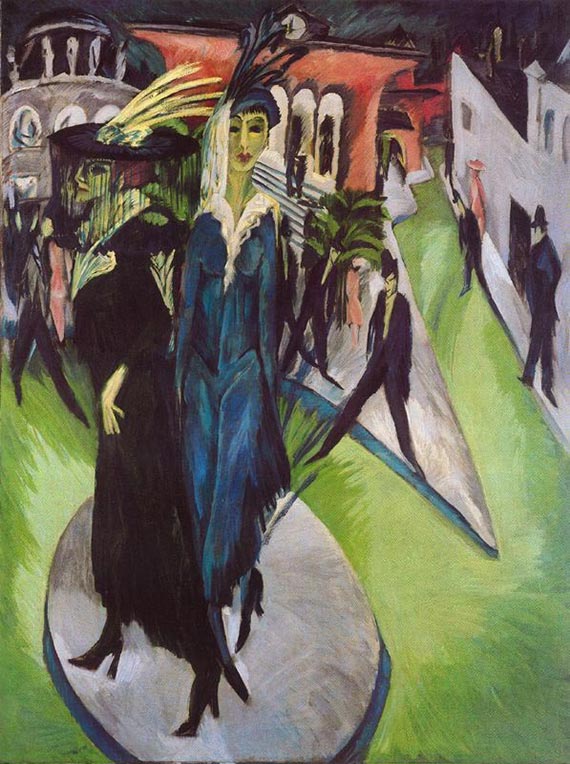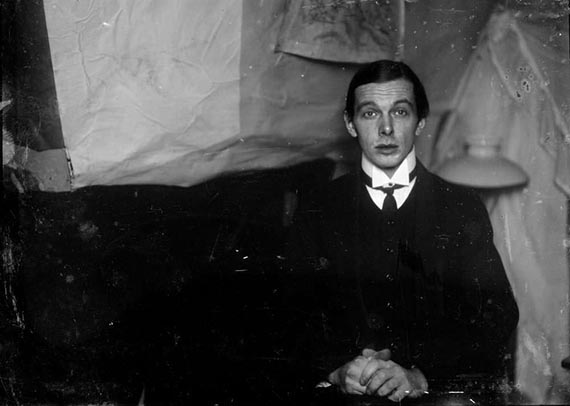Sale: 600 / Evening Sale, Dec. 05. 2025 in Munich  Lot 125001035
Lot 125001035
 Lot 125001035
Lot 125001035
125001035
Ernst Ludwig Kirchner
Frauen am Potsdamer Platz, 1914.
Woodcut, color print from one block, in monotyp...
Estimate:
€ 500,000 - 700,000
$ 580,000 - 812,000
Information on buyer's premium, taxation and resale right compensation will be available four weeks before the auction.
Ernst Ludwig Kirchner
1880 - 1938
Frauen am Potsdamer Platz. 1914.
Woodcut, color print from one block, in monotype style colored in black, blue, green, and red.
Signed in pencil lower right, inscribed “Handdruck” (handprint) by the artist in the lower left. Unique object. Only known color print. On blotting paper (stamped "Bonanza"). 52.2 x 38.5 cm (20.5 x 15.1 in).
• A rare print of museum quality: the only known color print of the famous woodcut from Kirchner's “Street Scenes” cycle (1913–1915).
• The iconic painting “Potsdamer Platz” (Neue Nationalgalerie, Berlin) was created in the same year.
Kirchner's “Street Prostitutes” symbolize the vibrant city of Berlin, with all its temptations and depths, shortly before the outbreak of World War I.
• Distorted perspectives and rhythmic forms heighten the expressionist tension to the point of a delirious alienation.
• To date, only one black-and-white copy has been offered on the international auction market (source: artprice.com).
• Black-and-white prints are in important collections, including the Städel Museum, Frankfurt am Main, the Kupferstichkabinett, Staatliche Museen zu Berlin, and the Museum Folkwang, Essen.
• Part of an acclaimed private collection in Berlin for over 30 years.
We are grateful to Prof. Dr. Günther Gercken for his kind expert advice.
PROVENANCE: Private collection, Berlin (acquired in 1992, Galerie Kornfeld, Bern).
EXHIBITION: Ernst Ludwig Kirchner, Kunstverein für die Rheinlande und Westfalen, Kunsthalle Düsseldorf, September 9–October 30, 1960, cat. no. 15 (with ill., different copy, b/w print).
Ernst Ludwig Kirchner, A Retrospective Exhibition, Seattle Art Museum, November 23, 1968–January 5, 1969; Pasadena Art Museum, January 16–February 23, 1969; Museum of Fine Arts, Boston, March 20–April 27, 1969, cat. no. 121 (with ill., different copy, b/w print).
Ernst Ludwig Kirchner und die Künstler der “Brücke”: Aquarelle, Zeichnungen und Graphik, Albertinum Dresden, November 30, 1968–January 19, 1969, cat. no. 96.
Ernst Ludwig Kirchner. Kirchner in Königstein, Aquarelle, Zeichnungen, Druckgrafik, Fotografien, Galerie der Jahrhunderthalle Hoechst, Frankfurt am Main, November 21, 1999–January 2, 2000, cat. no. 36 (with ill. p. 80, different copy, b/w print).
Ernst Ludwig Kirchner, 1880-1938, National Gallery of Art, Washington, D.C., March 2-June 1, 2003, cat. no. 132, illustrated in color (with the label on the back of the frame).
LITERATURE: Günther Gercken, Ernst Ludwig Kirchner. Kritisches Werkverzeichnis der Druckgraphik, vol. 3 (1912-1916), Bern 2015, CR no. 646 III.2 (of III.2, with ill. p. 121, different copies, b/w prints).
Annemarie and Wolf-Dieter Dube, E. L. Kirchner. Das graphische Werk, Munich 1967, CR no. H 239 b IV.
Gustav Schiefler, Die Graphik Ernst Ludwig Kirchners, vol. 1 (until 1916), Berlin-Charlottenburg 1926, CR no. 221.
- -
Annemarie Dube-Heynig, E. L. Kirchner. Graphik, Munich 1961, p. 23 (with full-page illustration, different copy, b/w print).
Eberhard W. Kornfeld, Ernst Ludwig Kirchner. Nachzeichnung seines Lebens, Katalog der Sammlung von Werken von Ernst Ludwig Kirchner im Kirchner-Haus Davos, Bern 1979, no, 115 (with illustration, p. 55, different copy, b/w print).
Galerie Kornfeld, Bern, 209th auction, 19th and 20th Century Art, Part I, June 26, 1992, lot 49 (with illustration).
Magdalena M. Moeller, Ernst Ludwig Kirchner, Die Straßenszenen: 1913-1915, Munich 1993, no. 80a (with ill. p. 143).
Gerd Presler, Ernst Ludwig Kirchner. Seine Frauen, seine Modelle, seine Bilder, Munich/New York 1998, p. 75 (with ill., different copy, b/w print).
Magdalena M. Moeller, Roland Scotti, Ernst Ludwig Kirchner. Gemälde, Aquarelle, Zeichnungen und Druckgraphik, Eine Ausstellung zum 60. Todestag, Munich 1998, p. 51 (with illustration, different copy, b/w print).
Christine E. Stauffer, Festschrift für Eberhard W. Kornfeld zum 80. Geburtstag, Bern 2003, p. 516.
Ernst Ludwig Kirchner: Farbige Druckgraphik, exhibition catalog, Brücke Museum, Berlin, September 3–November 23, 2008; Paula Modersohn-Becker Museum, Bremen, December 7, 2008–February 15, 2009, p. 13 (with ill.).
"The Berlin ‘Street Scenes’ are Kirchner's most important group of works. [..] They are the product of a modern metropolis. [..] Rapid perception, simultaneous movements and impressions, extreme tension and emotion, and a staccato style of drawing and painting are the distinguishing features of these works, created in all techniques; they constitute a climax in Kirchner's oeuvre."
Magdalena M. Moeller, quoted from: Ernst Ludwig Kirchner. Die Straßenszenen 1913-1915, Munich 1993, p. 24.
1880 - 1938
Frauen am Potsdamer Platz. 1914.
Woodcut, color print from one block, in monotype style colored in black, blue, green, and red.
Signed in pencil lower right, inscribed “Handdruck” (handprint) by the artist in the lower left. Unique object. Only known color print. On blotting paper (stamped "Bonanza"). 52.2 x 38.5 cm (20.5 x 15.1 in).
• A rare print of museum quality: the only known color print of the famous woodcut from Kirchner's “Street Scenes” cycle (1913–1915).
• The iconic painting “Potsdamer Platz” (Neue Nationalgalerie, Berlin) was created in the same year.
Kirchner's “Street Prostitutes” symbolize the vibrant city of Berlin, with all its temptations and depths, shortly before the outbreak of World War I.
• Distorted perspectives and rhythmic forms heighten the expressionist tension to the point of a delirious alienation.
• To date, only one black-and-white copy has been offered on the international auction market (source: artprice.com).
• Black-and-white prints are in important collections, including the Städel Museum, Frankfurt am Main, the Kupferstichkabinett, Staatliche Museen zu Berlin, and the Museum Folkwang, Essen.
• Part of an acclaimed private collection in Berlin for over 30 years.
We are grateful to Prof. Dr. Günther Gercken for his kind expert advice.
PROVENANCE: Private collection, Berlin (acquired in 1992, Galerie Kornfeld, Bern).
EXHIBITION: Ernst Ludwig Kirchner, Kunstverein für die Rheinlande und Westfalen, Kunsthalle Düsseldorf, September 9–October 30, 1960, cat. no. 15 (with ill., different copy, b/w print).
Ernst Ludwig Kirchner, A Retrospective Exhibition, Seattle Art Museum, November 23, 1968–January 5, 1969; Pasadena Art Museum, January 16–February 23, 1969; Museum of Fine Arts, Boston, March 20–April 27, 1969, cat. no. 121 (with ill., different copy, b/w print).
Ernst Ludwig Kirchner und die Künstler der “Brücke”: Aquarelle, Zeichnungen und Graphik, Albertinum Dresden, November 30, 1968–January 19, 1969, cat. no. 96.
Ernst Ludwig Kirchner. Kirchner in Königstein, Aquarelle, Zeichnungen, Druckgrafik, Fotografien, Galerie der Jahrhunderthalle Hoechst, Frankfurt am Main, November 21, 1999–January 2, 2000, cat. no. 36 (with ill. p. 80, different copy, b/w print).
Ernst Ludwig Kirchner, 1880-1938, National Gallery of Art, Washington, D.C., March 2-June 1, 2003, cat. no. 132, illustrated in color (with the label on the back of the frame).
LITERATURE: Günther Gercken, Ernst Ludwig Kirchner. Kritisches Werkverzeichnis der Druckgraphik, vol. 3 (1912-1916), Bern 2015, CR no. 646 III.2 (of III.2, with ill. p. 121, different copies, b/w prints).
Annemarie and Wolf-Dieter Dube, E. L. Kirchner. Das graphische Werk, Munich 1967, CR no. H 239 b IV.
Gustav Schiefler, Die Graphik Ernst Ludwig Kirchners, vol. 1 (until 1916), Berlin-Charlottenburg 1926, CR no. 221.
- -
Annemarie Dube-Heynig, E. L. Kirchner. Graphik, Munich 1961, p. 23 (with full-page illustration, different copy, b/w print).
Eberhard W. Kornfeld, Ernst Ludwig Kirchner. Nachzeichnung seines Lebens, Katalog der Sammlung von Werken von Ernst Ludwig Kirchner im Kirchner-Haus Davos, Bern 1979, no, 115 (with illustration, p. 55, different copy, b/w print).
Galerie Kornfeld, Bern, 209th auction, 19th and 20th Century Art, Part I, June 26, 1992, lot 49 (with illustration).
Magdalena M. Moeller, Ernst Ludwig Kirchner, Die Straßenszenen: 1913-1915, Munich 1993, no. 80a (with ill. p. 143).
Gerd Presler, Ernst Ludwig Kirchner. Seine Frauen, seine Modelle, seine Bilder, Munich/New York 1998, p. 75 (with ill., different copy, b/w print).
Magdalena M. Moeller, Roland Scotti, Ernst Ludwig Kirchner. Gemälde, Aquarelle, Zeichnungen und Druckgraphik, Eine Ausstellung zum 60. Todestag, Munich 1998, p. 51 (with illustration, different copy, b/w print).
Christine E. Stauffer, Festschrift für Eberhard W. Kornfeld zum 80. Geburtstag, Bern 2003, p. 516.
Ernst Ludwig Kirchner: Farbige Druckgraphik, exhibition catalog, Brücke Museum, Berlin, September 3–November 23, 2008; Paula Modersohn-Becker Museum, Bremen, December 7, 2008–February 15, 2009, p. 13 (with ill.).
"The Berlin ‘Street Scenes’ are Kirchner's most important group of works. [..] They are the product of a modern metropolis. [..] Rapid perception, simultaneous movements and impressions, extreme tension and emotion, and a staccato style of drawing and painting are the distinguishing features of these works, created in all techniques; they constitute a climax in Kirchner's oeuvre."
Magdalena M. Moeller, quoted from: Ernst Ludwig Kirchner. Die Straßenszenen 1913-1915, Munich 1993, p. 24.
Berlin, 1914. The city vibrates in a state of feverish excitement. Trains roll in and out of Potsdamer Bahnhof station. Electric lights flicker above the coffeehouse patios. The night air is filled with the sound of carriages, a babble of voices, and the music of cabarets. Amidst this urban choreography, two women stand motionless. Their presence resembles that of actresses on a stage, caught between an open spectacle and inner isolation.
Ernst Ludwig Kirchner's impressive woodcut “Frauen am Potsdamer Platz” (“Women at Potsdamer Platz,” 1914) is one of the most expressive and psychologically charged works in his “Street Scenes” cycle. This significant body of work comprises paintings, drawings, and prints in which Kirchner reflects on urban life on the eve of World War I. The works were created between 1913 and 1915 and document an artistic engagement with Modernism that is unparalleled in German Expressionism.
Kirchner in Berlin: The Birth of the “Street Scenes”
Kirchner moved from Dresden to Berlin in the fall of 1911 and immediately reacted to the dynamics and density found in the big city. The fast pace of life, the social contrasts, and the visual overstimulation of the metropolis provided him with new artistic inspiration. He began to paint scenes of everyday urban life that revealed the ambivalence of prewar Berlin. He only occasionally interrupted his work by withdrawing to the island of Fehmarn with his partner Erna Schilling.

In 1913, he entered into a phase marked by increased productivity, producing his first street scenes. Kirchner approached the city not as a neutral observer, but as a sensitive chronicler of a changing social landscape. He deliberately chose motifs such as cafés, boulevards, traffic junctions, and, above all, prostitutes, whom he saw not as caricatures, but as symptomatic figures of an alienated society.
During this period, Berlin emerged as a place of profound contradictions. Technological progress and urban glamour collided with misery, social isolation, and inner emptiness. Kirchner's work was an aesthetic reflection of these contrasts. In 1914, just a few months after completing his monumental oil painting ‘Potsdamer Platz’, which is on display at the Nationalgalerie Berlin today, World War I broke out. An event that marked a tectonic shift, shattering the artistic utopias of the avant-garde.
The "Cocottes – Ambivalence and Psychological Projection
Kirchner gradually turned his attention to the so-called cocottes – characters who existed in the space between availability, self-promotion, and marginalization. Sociological observation and personal projection are intertwined in depictions of these women. The cocottes become representatives of social imbalance, but also a reflection of his own psychological turmoil. In a letter to Gustav Schiefler from 1915, Kirchner wrote: "[...] Like the cocottes I painted, I am just the same. Wiped out, gone" (Ernst Ludwig Kirchner, quoted from: Wolfgang Henze, Ernst Ludwig Kirchner, Gustav Schiefler, Briefwechsel 1910-1935/1938, Stuttgart 1990, p. 83).

In “Frauen am Potsdamer Platz”, Kirchner combines the theme of the modern woman with a highly reduced yet expressive visual language. The composition is condensed into angular forms, sharp diagonals, and a dynamic, reduced pictorial space. Only the two central figures and the shadowy outline of the station building are colored in blue, green, and red. The rest of the scene remains in a graphically austere black and white. The women are depicted as self-assured protagonists, facing head-on and in profile. One wears a feather-adorned hat; both appear proud but aloof. Their position on a traffic island spatially isolates them from the hustle and bustle of the city while also giving them an iconic presence. They seem conscious of being observed and at the same time withdrawn. The contrast between color and monochrome, between surface and line, unfolds a multi-layered symbolism. The visible and the invisible, seduction and danger, self-presentation and social projection stand in juxtaposition. Kirchner's image of women oscillates between empathy and distance, between aesthetic fascination and psychological mystery.
Between two media: Painting and printmaking
The woodcut “Frauen am Potsdamer Platz” exists in direct exchange with the painting of the same name from 1914. Both works depict two female figures on a traffic island, framed by elements of Potsdamer Platz, including Café Piccadilly and the landmark train station building.
The woodcut technique requires a mirror-image reversal of the composition. In contrast to the painting, in which the women look to the right, they turn to the left in the print. This shift lends the graphic version an autonomous compositional structure. While the painting operates with a panoramic format and intense colors, the woodcut thrives on the haptic presence of the incisions and the contrasting surface effects.

Printmaking Particularity
Kirchner attaches particular importance to woodcut printing within his oeuvre. He describes it as “the most graphic of the graphic techniques” (Ernst Ludwig Kirchner, quoted from: Magdalena M. Moeller (ed.), ausloten, Texte zur Kunst des 20. Jahrhunderts, Munich 2019, p. 37). For color prints, he either used a single block, which he colored by hand, or several printing blocks, which he colored separately and applied in varying order. This results in a unique chromatic composition of each print. These experimental techniques can also be seen in the present print “Frauen am Potsdamer Platz”, the only known colored copy from a total of twelve copies from the plate. It combines technical finesse with emotional intensity. Here, Kirchner attained a pictorial density that can be considered the culmination point within his Street Scenes.
With unyielding directness and formal rigor, Kirchner's visionary woodcut scrutinizes Berlin in an era that oscillates between allure and decay. The work not only articulates a personal response to modernity but also serves as a key image of expressionist style, highlighting the tension between urbanity, identity, and psychological fragility. [KA]

Ernst Ludwig Kirchner's impressive woodcut “Frauen am Potsdamer Platz” (“Women at Potsdamer Platz,” 1914) is one of the most expressive and psychologically charged works in his “Street Scenes” cycle. This significant body of work comprises paintings, drawings, and prints in which Kirchner reflects on urban life on the eve of World War I. The works were created between 1913 and 1915 and document an artistic engagement with Modernism that is unparalleled in German Expressionism.
Kirchner in Berlin: The Birth of the “Street Scenes”
Kirchner moved from Dresden to Berlin in the fall of 1911 and immediately reacted to the dynamics and density found in the big city. The fast pace of life, the social contrasts, and the visual overstimulation of the metropolis provided him with new artistic inspiration. He began to paint scenes of everyday urban life that revealed the ambivalence of prewar Berlin. He only occasionally interrupted his work by withdrawing to the island of Fehmarn with his partner Erna Schilling.

Ernst Ludwig Kirchner, Nollendorfplatz, 1912, oil on canvas, Stiftung Stadtmuseum Berlin.
In 1913, he entered into a phase marked by increased productivity, producing his first street scenes. Kirchner approached the city not as a neutral observer, but as a sensitive chronicler of a changing social landscape. He deliberately chose motifs such as cafés, boulevards, traffic junctions, and, above all, prostitutes, whom he saw not as caricatures, but as symptomatic figures of an alienated society.
During this period, Berlin emerged as a place of profound contradictions. Technological progress and urban glamour collided with misery, social isolation, and inner emptiness. Kirchner's work was an aesthetic reflection of these contrasts. In 1914, just a few months after completing his monumental oil painting ‘Potsdamer Platz’, which is on display at the Nationalgalerie Berlin today, World War I broke out. An event that marked a tectonic shift, shattering the artistic utopias of the avant-garde.
The "Cocottes – Ambivalence and Psychological Projection
Kirchner gradually turned his attention to the so-called cocottes – characters who existed in the space between availability, self-promotion, and marginalization. Sociological observation and personal projection are intertwined in depictions of these women. The cocottes become representatives of social imbalance, but also a reflection of his own psychological turmoil. In a letter to Gustav Schiefler from 1915, Kirchner wrote: "[...] Like the cocottes I painted, I am just the same. Wiped out, gone" (Ernst Ludwig Kirchner, quoted from: Wolfgang Henze, Ernst Ludwig Kirchner, Gustav Schiefler, Briefwechsel 1910-1935/1938, Stuttgart 1990, p. 83).

Potsdamer Platz, 1914.
In “Frauen am Potsdamer Platz”, Kirchner combines the theme of the modern woman with a highly reduced yet expressive visual language. The composition is condensed into angular forms, sharp diagonals, and a dynamic, reduced pictorial space. Only the two central figures and the shadowy outline of the station building are colored in blue, green, and red. The rest of the scene remains in a graphically austere black and white. The women are depicted as self-assured protagonists, facing head-on and in profile. One wears a feather-adorned hat; both appear proud but aloof. Their position on a traffic island spatially isolates them from the hustle and bustle of the city while also giving them an iconic presence. They seem conscious of being observed and at the same time withdrawn. The contrast between color and monochrome, between surface and line, unfolds a multi-layered symbolism. The visible and the invisible, seduction and danger, self-presentation and social projection stand in juxtaposition. Kirchner's image of women oscillates between empathy and distance, between aesthetic fascination and psychological mystery.
Between two media: Painting and printmaking
The woodcut “Frauen am Potsdamer Platz” exists in direct exchange with the painting of the same name from 1914. Both works depict two female figures on a traffic island, framed by elements of Potsdamer Platz, including Café Piccadilly and the landmark train station building.
The woodcut technique requires a mirror-image reversal of the composition. In contrast to the painting, in which the women look to the right, they turn to the left in the print. This shift lends the graphic version an autonomous compositional structure. While the painting operates with a panoramic format and intense colors, the woodcut thrives on the haptic presence of the incisions and the contrasting surface effects.

Ernst Ludwig Kirchner, Potsdamer Platz, 1914, oil on canvas, Neue Nationalgalerie, Berlin.
Printmaking Particularity
Kirchner attaches particular importance to woodcut printing within his oeuvre. He describes it as “the most graphic of the graphic techniques” (Ernst Ludwig Kirchner, quoted from: Magdalena M. Moeller (ed.), ausloten, Texte zur Kunst des 20. Jahrhunderts, Munich 2019, p. 37). For color prints, he either used a single block, which he colored by hand, or several printing blocks, which he colored separately and applied in varying order. This results in a unique chromatic composition of each print. These experimental techniques can also be seen in the present print “Frauen am Potsdamer Platz”, the only known colored copy from a total of twelve copies from the plate. It combines technical finesse with emotional intensity. Here, Kirchner attained a pictorial density that can be considered the culmination point within his Street Scenes.
With unyielding directness and formal rigor, Kirchner's visionary woodcut scrutinizes Berlin in an era that oscillates between allure and decay. The work not only articulates a personal response to modernity but also serves as a key image of expressionist style, highlighting the tension between urbanity, identity, and psychological fragility. [KA]

Ernst Ludwig Kirchner, Self portrait in his studio apartment in Berlin-Friedenau, 1913/1915, (Kirchner Museum Davos, Schenkung Nachlass Ernst Ludwig Kirchner 2001)
125001035
Ernst Ludwig Kirchner
Frauen am Potsdamer Platz, 1914.
Woodcut, color print from one block, in monotyp...
Estimate:
€ 500,000 - 700,000
$ 580,000 - 812,000
Information on buyer's premium, taxation and resale right compensation will be available four weeks before the auction.
Headquarters
Joseph-Wild-Str. 18
81829 Munich
Phone: +49 89 55 244-0
Fax: +49 89 55 244-177
info@kettererkunst.de
Louisa von Saucken / Undine Schleifer
Holstenwall 5
20355 Hamburg
Phone: +49 40 37 49 61-0
Fax: +49 40 37 49 61-66
infohamburg@kettererkunst.de
Dr. Simone Wiechers / Nane Schlage
Fasanenstr. 70
10719 Berlin
Phone: +49 30 88 67 53-63
Fax: +49 30 88 67 56-43
infoberlin@kettererkunst.de
Cordula Lichtenberg
Gertrudenstraße 24-28
50667 Cologne
Phone: +49 221 510 908-15
infokoeln@kettererkunst.de
Hessen
Rhineland-Palatinate
Miriam Heß
Phone: +49 62 21 58 80-038
Fax: +49 62 21 58 80-595
infoheidelberg@kettererkunst.de
We will inform you in time.





